Cooking can be a very powerful way to reconnect with one’s origins. Most of my ancestors immigrated to what is now the United States hundreds of years ago, intermarrying with people of various other national and ethnic origins. Yet even after several centuries of genealogical mixing, the family names Gordon and Moffat have been preserved and passed down, allowing me to trace at least two of my ancestral lineages to specific clans in specific regions of Scotland. When in July 2016, I visited England to attend the Oxford Centre for Animal Ethics’ annual Summer School at the University of Oxford, I took the opportunity afterward to travel north to Scotland and spend a week and a half exploring the country and reconnecting with my roots.
Ever since my return to the United States, I have been obsessed with further exploring my cultural heritage in the kitchen. By learning Scottish recipes, then substituting vegan ingredients instead of animal-based ones, I seek to harmonize my ancestors’ traditions with the value of compassion for all sentient beings, so making them my own.
Below are four recipes I have practiced and perfected to the point that I am now confident sharing them with the world. Whatever your national or ethnic origin, I invite you to try them out yourself. Please share any feedback you may have. Then try making vegan versions of traditional recipes from your own ancestral cultures, and share your results with the Animal People Forum!

Cock-A-Leekie Soup
A fragrant soup rich in flavor, the seemingly suggestive name “Cock-A-Leekie” refers simply to chicken and leeks, the traditional core ingredients. Potatoes and/or barley provide much of the body, and can be varied in amount depending on whether you’re making the soup as an appetizer or an entree (note that these ingredients may absorb some of the seasoning, and adjust spice levels accordingly). Prunes are an old-fashioned element rarely used in most modern recipes, but in my opinion they add a great deal to the flavor of the soup and should not be dispensed with lightly.
Ingredients:
- 4 pieces (10 ounces) of Gardein Chick’n Scallopini (rinsed to remove spice rub), or equivalent amount of preferred chicken alternative
- 3 small leeks
- 2-4 gold potatoes (optional)
- 1/2 cup barley (optional)
- 2 celery sticks
- 1 large handful of baby carrots
- 2 tablespoons of vegetable oil
- 8 cups of water
- 1 cup of pitted prunes
- 1 tablespoon of parsley
- 2 teaspoons of salt
- 1/2 teaspoon of thyme
- 1/4 teaspoon of black pepper
- 2 bay leaves
Procedure:
- Add 2 tablespoons of vegetable oil to a large saucepan. Fry Gardein from frozen until soft (about 5 minutes), then remove and set aside.
- If using potatoes, boil them at the same time in a separate pot, until skin becomes loose. Then peel under cold rinse, quarter, and set aside.
- If using barley, add to saucepan and fry for 1-2 minutes on its own. Add chopped carrots, celery, and leeks to saucepan, fry for about 5 more minutes.
- Cut Gardein into chunks, return to saucepan with vegetables. Add water. Cover saucepan, bring to a rapid boil and then simmer for about 40 minutes, stirring occasionally.
- Add potatoes (if using) and prunes to saucepan. Add parsley, salt, thyme, pepper, and bay leaves in amounts given or to personal taste.
- Simmer uncovered for another 20 minutes, stirring occasionally. Remove bay leaves (they exude delicious flavor, but are themselves inedible) and serve hot with your favorite bread!
- Chopped Gardein
- Vegetables frying
- Finished soup

Serving suggestion: Haggis with mashed potatoes and carrots on a bed of wilted spinach, topped with tomato whisky sauce
Mushroom Haggis
Though widely feared even by meat lovers for its reputed gruesomeness, in taste and texture haggis can be described as a savory oatmeal, and the ingredients it uses are hardly different from those contained in a typical American hot dog. There are many recipes available for “vegetarian haggis,” but few have much in common with their inspiration, most being baked rather than boiled and using various vegetables and spices completely foreign to the traditional dish. This recipe is designed to closely resemble traditional haggis in ingredients, procedure, taste and texture alike, swapping out only the animal components while keeping everything else as similar as possible.
Ingredients:
- 1 portobello mushroom cap
- 3-4 ounces oyster mushrooms
- 1 can of kidney beans
- 2 tablespoons vegetable oil
- 2 onions
- 8 ounces of oatmeal
- 1 tablespoon of salt
- 2 teaspoons of nutmeg
- 1 teaspoon of black pepper
- 1 teaspoon of coriander
- 4 large savoy cabbage leaves
- Cheesecloth
Procedure:
- Chop mushrooms and onions, fry for several minutes in vegetable oil.
- Toast oatmeal for several minutes until it’s slightly browned and fragrant.
- Finely mince mushrooms and onions with kidney beans in blender, or using a hand tool.
- Pour minced ingredients into mixing bowl. Add oatmeal and spices, along with any extra cooking oil.
- Spoon mixture into a cabbage leaf until full. Cover with second cabbage leaf, then enclose with two remaining leaves and wrap tightly with cheesecloth. The less moisture gets in while boiling, the better (although a little water is inevitable).
- Place in a cooking pot full of water, bring to a boil and simmer for two and a half hours, adding additional water and adjusting heat as needed.
- Cut open wrapping and empty haggis mixture into a serving bowl, discarding cheesecloth and soaked leaves. Mix well to distribute any moisture, and allow to cool and set before serving.
- Step 3 – mincing in blender
- Step 5 – wrapping in cabbage leaves
- Step 6 – boiling
- Step 7 – cooling in bowl
Haggis is traditionally served together with mashed potatoes and turnips (“neeps and tatties”), though I personally prefer potatoes and carrots. It also goes nicely with rumbledethumps (see below). If you desire a condiment, you can simply use HP brown sauce or a splash of Scotch whisky, or you can create a Scotch whisky sauce like this one. Feel free to experiment with various uses for leftovers – in Scotland, haggis is used as everything from a burger mix to a pasta topping!
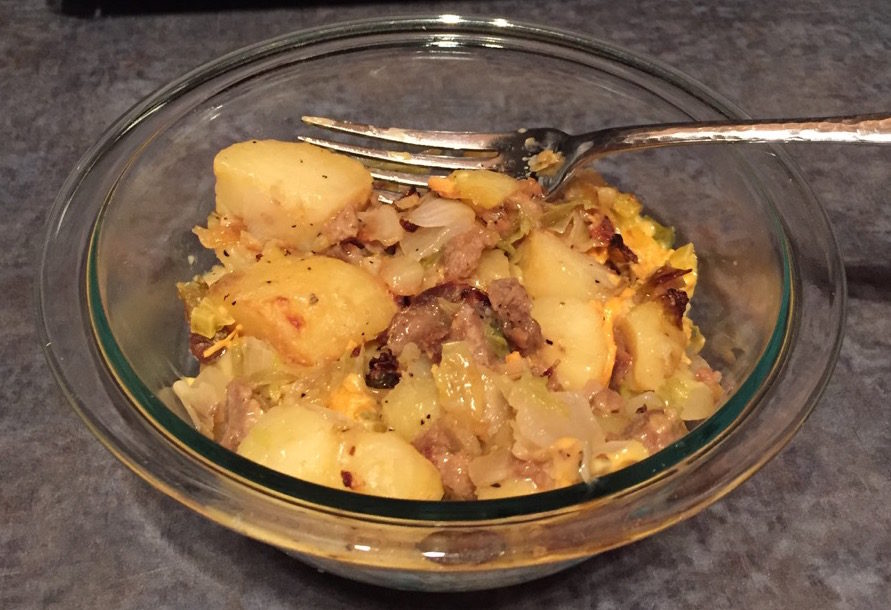
Rumbledethumps
A casserole dish consisting primarily of cabbage, onions, and potatoes, Scottish rumbledethumps is part of the same culinary family as British bubble-and-squeak and Irish colcannon. Rumbledethumps is vegetarian by default, albeit traditionally very heavy in butter and cheese. The name, less suggestive than “Cock-A-Leekie” but still a little odd-sounding to the American ear, supposedly comes from the sounds the dish makes while cooking – though to be honest, in all the times I’ve made it I have yet to hear any rumbling or thumping from the oven. Originally invented to utilize common leftovers, rumbledethumps is a very flexible dish, and the ratios of major ingredients can easily be adjusted to taste.
Ingredients:
- 4-6 gold potatoes
- 6-10 Savoy cabbage leaves
- 1 or 2 onions
- 3-6 ounces of beefless crumbles or tempeh bacon (optional – use if making as an entree, skip if meant as a side dish). If frozen, thaw before using.
- 4 tablespoons margarine or vegan butter (I prefer Miyoko’s European Style Cultured Butter, available at Trader Joe’s)
- 6-8 tablespoons of vegan cheddar cheese shreds (I like to use a mixture of shredded Daiya cheddar and finely chopped plain Chao)
- 1 teaspoon salt
- 1/2 teaspoon black pepper
Procedure:
- Boil potatoes until skin becomes loose and starts to crack. Peel under cold rinse, cut into chunks, and set aside.
- Shred cabbage leaves, removing stems, and mince onions.
- Melt vegan butter in a large frying pan, then add cabbage and onion. Stir well and fry for several minutes, until cabbage becomes wilted and bright green in color. Do not allow to brown.
- Add crumbled meat alternative, if using, and fry for another minute or so.
- Add potatoes and half the cheese to the pan. Season with salt and pepper, in amounts given or to personal taste, and stir for about a minute or until cheese begins to melt.
- Place in a baking dish, and sprinkle the remaining cheese on top.
- Bake for 30 minutes in oven, preheated to 400 degrees Fahrenheit / 200 degrees Celsius, or until cheese is completely melted and potatoes appear golden brown. Allow to cool slightly and then serve!
- Before baking…
- …All finished!

Serving suggestion: Raspberry Coconut Cranachan with Singin’ Hinnies (also known as Fatty Cutties, a Scottish griddle cake made with currants)
Coconut Cranachan
Reminiscent of a parfait, cranachan is a very quick and easy dessert to make, and being cold, light, and sweet, makes for a perfectly refreshing finish to any hearty Scottish dinner. Cranachan is traditionally made with raspberries, though because my mother doesn’t care for their seedy texture, I usually use blueberries instead when I cook for her. Feel free to experiment with other fruit options. The higher quality the Scotch whisky you use, the tastier the final product will be – that said, the hefty price of good imported Scotch should not dissuade you, as I’ve used bottom-tier $9 whisky from Safeway and still gotten delicious results.
Ingredients:
- 2 tbsp oatmeal
- 300 grams raspberries (or other berries of your choice)
- 1 can of full fat coconut cream
- ½ cup powdered sugar
- 2 tablespoons agave syrup
- 2 tablespoons Scotch whisky
Procedure:
- (Several hours before) Refrigerate coconut cream.
- Toast oatmeal for several minutes until fragrant and slightly browned.
- Crush half the berries with a fork, leaving the other half intact.
- Spoon out hardened coconut cream into chilled mixing bowl, discarding liquid or saving for another purpose. Beat for 30 seconds with electric mixer until soft and creamy.
- Add powdered sugar to coconut cream and beat for another minute.
- Stir in agave syrup, Scotch whisky, and oatmeal to cream.
- Layer cream, oatmeal, crushed and whole berries in glass cups and serve while still cold.

A complete vegan Scottish dinner. Left to right: Mushroom Haggis, Rumbledethumps, Blueberry Coconut Cranachan, and Cock-A-Leekie Soup


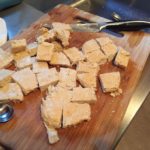



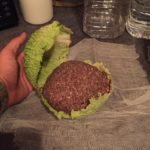
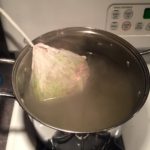


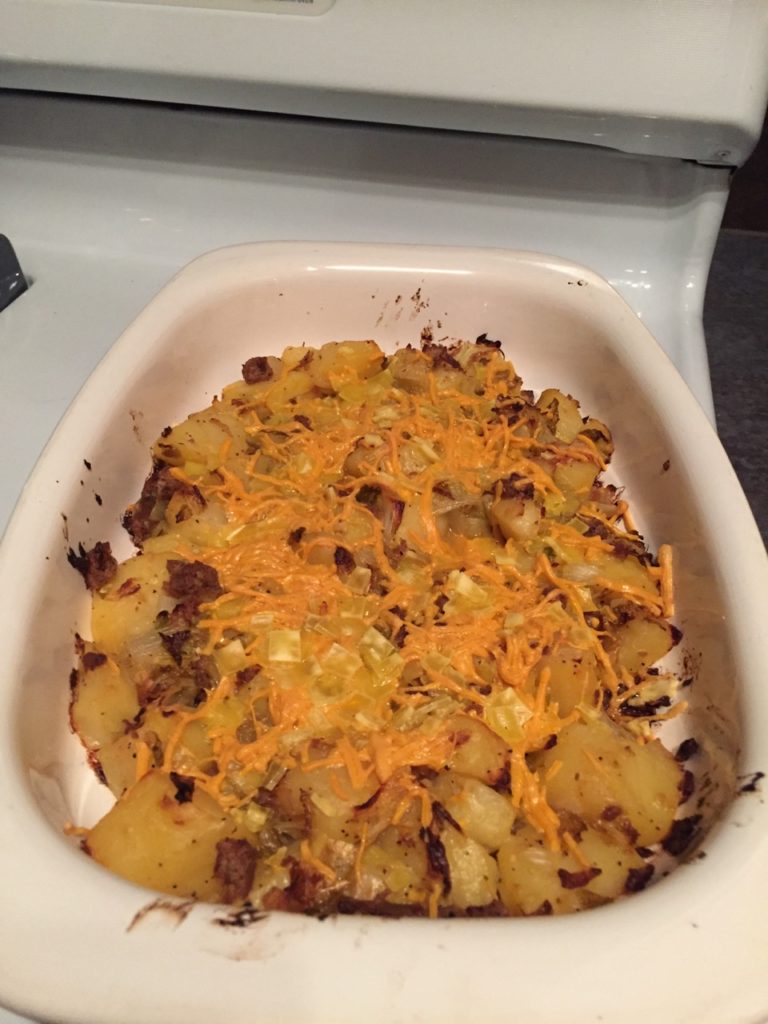




1 Comment
Hey Wolf!
Thanks so much for making and posting up these scrumptious recipes! I made the soup and the haggis but instead made the haggis into dumplings (haggis-bags) for my soup! It really is a delicious recipe. I created a recipe going off of yours, so thank you! If you’d like to see how I did it, check my recent blog post! Thanks again, and keep doing what you do, Wolf.
Best,
Renee